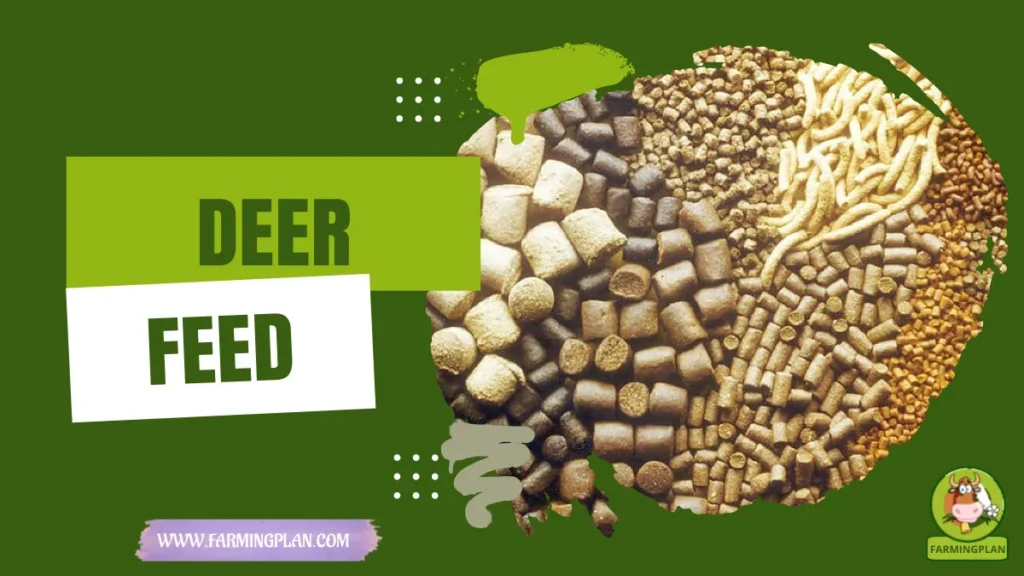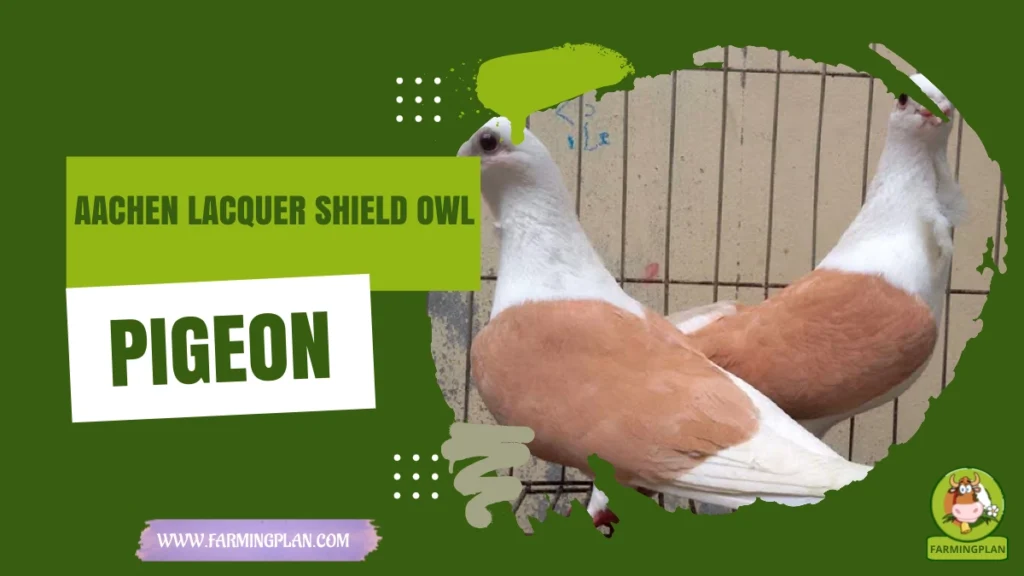The Exmoor Pony Horse is more than just a cute face—it’s a living symbol of Britain’s ancient wild heritage. With its hardy nature, weatherproof coat, and deep roots in Exmoor’s rugged hills, this native pony captures the hearts of horse lovers, pet owners, and conservationists alike. Whether you’re a hobbyist, a family looking for a beloved companion, or someone involved in nature preservation, this article will guide you through everything you need to know about the Exmoor Pony. From its fascinating history to practical care tips, let’s uncover why this sturdy, adaptable pony continues to win over people across the globe.
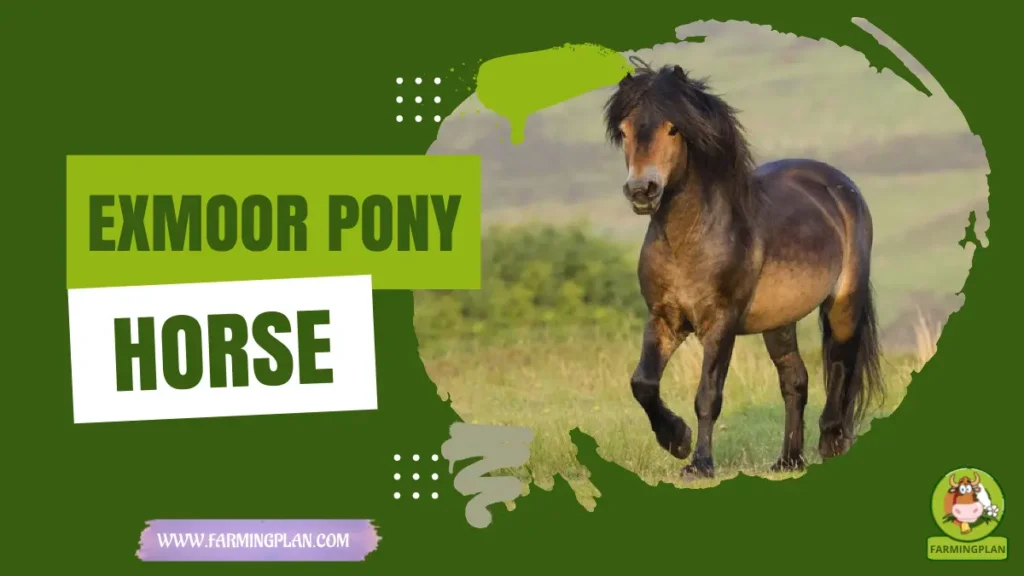
History & Origin of Exmoor Pony Horse
Exmoor Pony Horse is one of the oldest and purest native pony breeds in Britain. Some experts believe these ponies are direct descendants of ancient wild horses that roamed the moorlands thousands of years ago. Drawings from the 19th century already show ponies similar to the modern Exmoor Pony Horse, with strong builds and signature features. During the 20th century, enthusiasts like Mary Etherington began dedicated breeding programs to save the breed from extinction. Thanks to her and others, the Exmoor Pony Society formed and created a stud book to protect the genetic line.
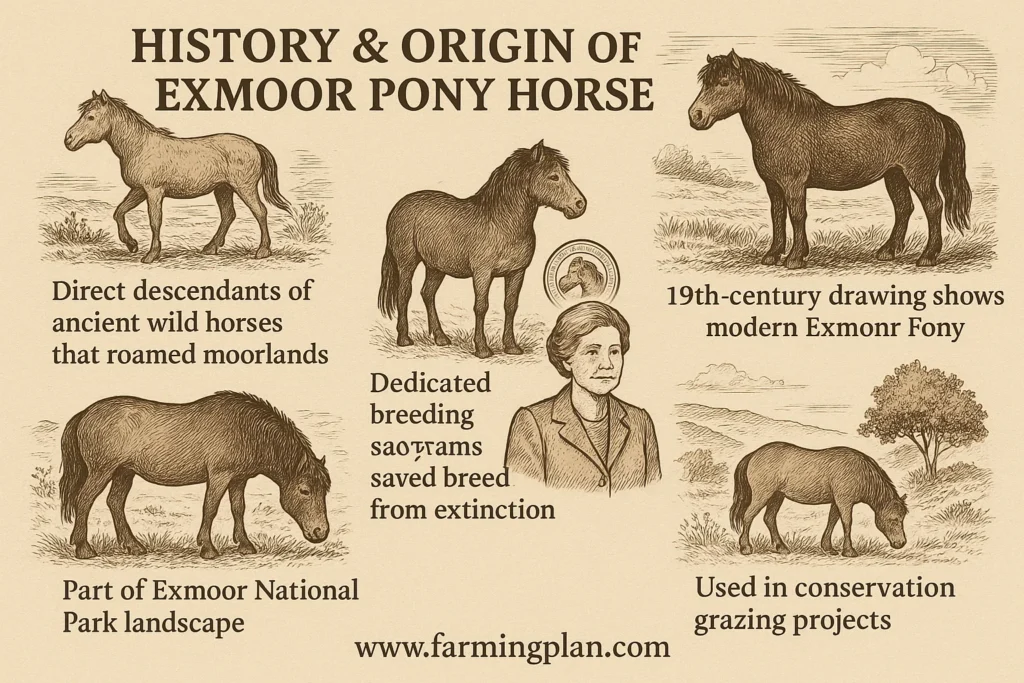
This pony has always been a part of the Exmoor National Park landscape. Over time, farmers used them for target practice, sadly reducing numbers. World War II also hit populations hard. Yet, their resilience and the love of breed stewards helped them bounce back. Today, breeding programs stretch beyond Britain, with small populations in North America as well. The breed has become a conservation niche, used in conservation grazing projects to maintain biodiversity across nature reserves.
Characteristics of Exmoor Pony Horse
The Exmoor Pony Horse stands out with its weather-resistant look and classic brown coat. It typically has no white markings, and its coat colour ranges from dark brown to black, sometimes with a lighter “mealy” muzzle and eyes. One of its most unique features is the toad eye—a raised upper lid structure that protects the eyes from wind and rain. Their coarse hairs and two-layered winter coat help them stay warm during harsh winters, while their summer coat sheds neatly for hotter months.
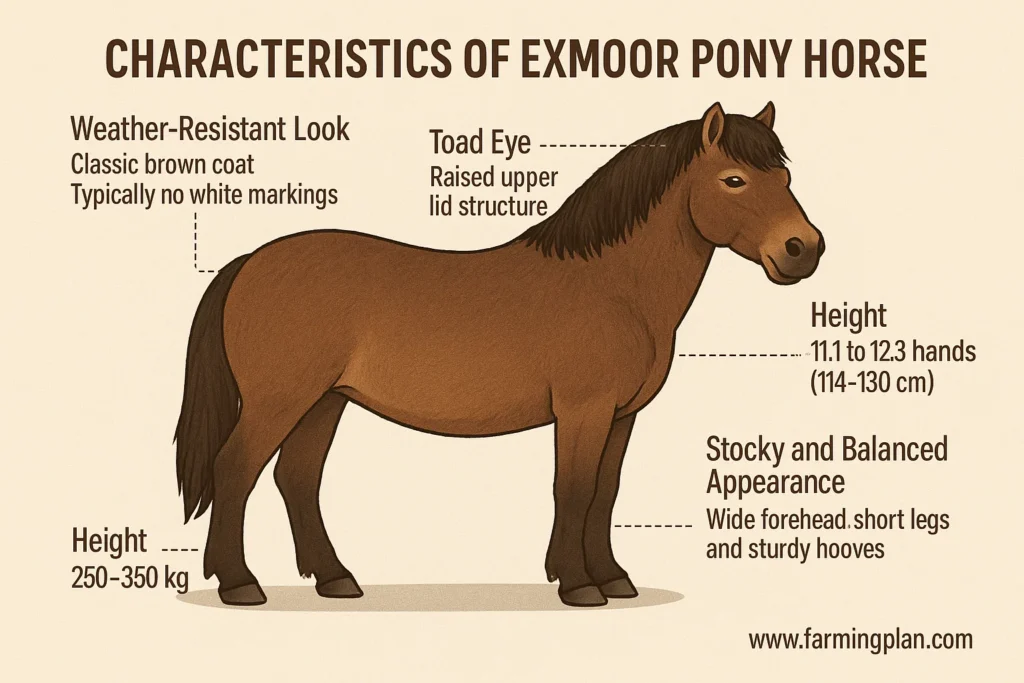
In terms of size, these ponies stay compact. The average height ranges from 11.1 to 12.3 hands (about 114 to 130 cm), making them great for young riders or conservation work. They also maintain a manageable body weight of 250 to 350 kg. Their appearance is stocky and balanced, with a wide forehead, short legs, and sturdy hooves. When compared to the Dartmoor Pony, the Exmoor is bulkier and more primitive in appearance. This pony’s characteristic appearance makes it easily recognizable in the moorlands of Britain.
Read more: Dartmoor Pony Horse: Avoid These Common Mistakes and Embrace Their Strength
Nature & Temperament of Exmoor Pony Horse
This pony’s nature is shaped by its wild background. The Exmoor Pony Horse is smart, alert, and deeply connected to herd life. Though it may seem shy or cautious around strangers, it quickly warms up with gentle handling. Known for being pony safe, these animals make beloved family ponies when raised correctly. They are gentle with children and easy to train for light riding or groundwork.
Their temperament is often described as adaptable. Whether you keep them on a farm, in a pasture, or as part of a wildlife reserve, they adjust quickly. Their herd instinct is strong—they do best with companions or in small groups. As sturdy ponies, they are low-maintenance and rarely require intense training. However, early socialization is essential for turning a semi-wild pony into a calm and responsive companion.
Food & Diet of Exmoor Pony Horse
Exmoor Pony Horse are known for thriving on simple, rough moorland forages. They’ve evolved to survive in low-nutrient environments, so rich grain diets aren’t suitable. Most of their nutrition should come from grass hay and pasture grazing. Free access to clean water is a must, along with access to a salt lick or mineral block. To maintain body weight, avoid overfeeding. Use the 9-point Henneke Body Condition Scale to monitor weight regularly.
A balanced feeding program includes seasonal adjustments. In winter, supplement with hay but avoid sugary grains. Their coarse winter coat may hide signs of weight loss, so it’s vital to check their condition under the hair. If unsure, work with qualified equine nutritionists to design a feeding plan. This helps prevent excessive weight gain and keeps their skin health in check too.
Read more: Discover the Charm of Shetland Pony Horse: A Little Horse with a Big Personality
Usage & Purpose of Exmoor Pony Horses
The Exmoor Pony Horse serves many roles today. Originally used for light farm work, they are now popular in conservation grazing, helping to manage natural habitats. Their grazing style encourages biodiversity by eating dominant plants, allowing rare wildflowers and insects to thrive. They’ve become essential for environmental conservation on protected lands.
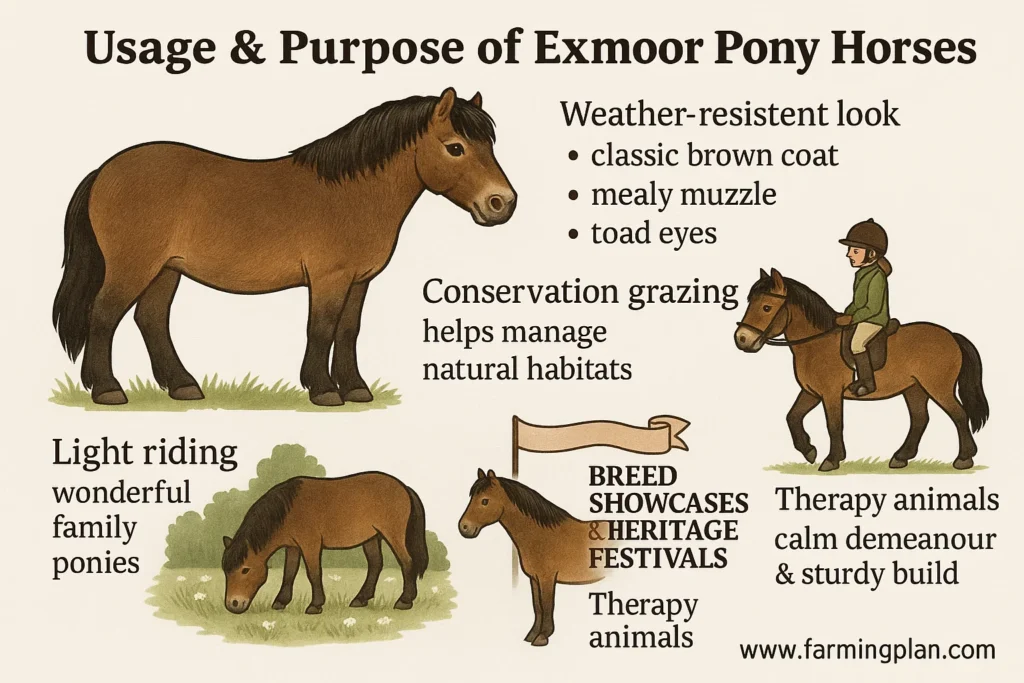
Besides conservation, these ponies make wonderful family ponies for light riding. They also feature in breed showcases and heritage festivals in the UK. Though they’re not suited for competitive equestrian sports, they offer joy and companionship. Some pony owners even use them as therapy animals due to their calm demeanor. Their sturdy build, easy care, and rich history make them an appealing choice for those who value tradition and sustainability.
Special Features That Make the Exmoor Pony Unique
Exmoor Pony Horses have several traits that make them unlike any other British breed pony. Their two-layered winter coat, with a woolly underlayer and rain-shedding topcoat, is nature’s perfect design. Their toad eyes and short ears protect them from wind and snow, making them well-suited to British conditions.
These ancient ponies also have unique genes, shown by studies in the Equine Vet Journal. Their genetic diversity is critical, and conservation groups prioritize it in breeding programs. You won’t find many black ponies among them—they usually have a signature brown look with a mealy tan around the eyes and nose. Their sturdy pony frame allows them to survive in challenging climates with little help, making them one of the most adaptable ponies around.
Health Issues & Prevention in Exmoor Ponies
Exmoor Pony Horse are known for their robust health. However, they are not immune to problems. Like all horses, they can suffer from laminitis, obesity, or blindness in horses. The key to health is prevention. Stick to an annual wellness program that includes dental care, hoof trimming, vaccinations, and deworming. Keep track of their body condition score using the Henneke scale. Watch for sudden weight changes, especially during seasonal transitions.
Some ponies may also react poorly to rich pastures, so limit access during spring. Work with your vet to monitor antibody response and address early signs of illness. Tip: Monitor your pony’s body condition score monthly using the Henneke Scale for early health insights. With proper care, most Exmoors live long, healthy lives well into their 30s.
Read more: Fell Pony Horse: Why This Underrated Breed Will Surprise You with Its Strength
Step-by-Step Pet Owner Care Guide for an Exmoor Pony Horse
Want to keep your Exmoor Pony Horse happy, healthy, and thriving? This simple, step-by-step care guide will walk you through everything from creating the right environment to proper feeding, grooming, bonding, and health monitoring. Whether you’re a first-time owner or experienced handler, these practical tips will help ensure your pony stays in peak condition all year round.
Step 1: Set Up a Safe and Comfortable Living Space
Exmoor Ponies thrive in environments that closely resemble their native moorland. Start by choosing a spacious paddock or pasture that allows for natural movement. Ideally, the area should include natural shelter like trees or hedges, but a three-sided run-in shed can also provide protection from harsh weather. These ponies are extremely hardy, but still need relief from heavy wind, rain, and summer heat.
Install secure, horse-safe fencing—avoid barbed wire as it can cause injuries. Electric fencing is a great addition for preventing leaning or pushing. The ground should be well-drained to avoid hoof problems from standing in wet conditions for too long. Make sure there’s no toxic vegetation like ragwort or yew trees, which can be deadly to horses.
Step 2: Provide a Balanced, Forage-Based Nutrition Plan
The Exmoor Pony evolved on sparse, rugged terrain, so its digestive system is best suited to a high-fiber, low-sugar diet. Feeding should focus on quality grass hay, with controlled grazing during lush spring and summer months to prevent obesity or laminitis. Avoid grain-based feeds unless specifically recommended by a vet or nutritionist.
Fresh, clean drinking water must always be available, even in freezing weather. Add a salt lick or mineral block to support electrolyte balance and encourage hydration. In winter, when natural forage is limited, supplement with additional hay and consider a forage balancer if your pony’s coat or energy levels drop. Tip: Consult with a qualified equine nutritionist for a custom plan tailored to your pony’s age, weight, and workload.
Step 3: Establish Regular Grooming and Coat Care
Exmoor Ponies have a double-layered coat, especially in winter. The undercoat traps heat, while the outer coat sheds rain, so it’s crucial not to clip or shave unless absolutely necessary. Instead, use a rubber curry comb or dandy brush to remove mud, burrs, and loose hair without damaging the protective layers. Check their skin and coat health during grooming—look for bald patches, scabs, or signs of skin irritation. In warmer months, their thick coat will naturally shed, and you can groom more frequently to help the process. Don’t forget to pick out hooves daily and inspect for signs of thrush, cracks, or embedded stones. A regular grooming routine also builds trust and strengthens your bond.
Step 4: Socialize and Build Trust With Your Pony
Exmoor Ponies are herd animals and don’t do well in isolation. Ideally, keep your pony with at least one companion—another pony, donkey, or calm horse—to prevent loneliness and stress. New owners should spend time every day doing non-threatening activities like hand-grazing, brushing, or simple walks. Training should begin with groundwork, including leading, standing still, and responding to gentle pressure. These ponies are intelligent and quick to learn, but can be cautious with new people. Use calm, consistent cues and avoid punishment-based techniques. Positive reinforcement, such as praise or a scratch on the withers, goes a long way in developing trust and good manners.
Step 5: Monitor Health and Wellness Year-Round
Even though Exmoor Ponies are generally hardy, regular health monitoring is essential. Use the 9-point Henneke Body Condition Scale every month to assess fat cover over key areas like the ribs, withers, and tailhead. Keep written records of any weight gain or loss, which could signal nutritional issues or health concerns. Schedule routine veterinary visits, including vaccinations, dental checks, and fecal egg counts for deworming. Hoof trims should occur every 6–8 weeks, depending on hoof growth and ground conditions. Watch for signs of distress or discomfort, such as changes in eating, behavior, or coat texture. Prompt care and regular checkups will help your Exmoor live a long, vibrant life—often 30 years or more.
Tough As The Moorlands, Sweet As A Pony’s Whinny—That’s The Spirit Of The Exmoor Pony Horse.
Expert Tips & Best Practices for Exmoor Pony Owners
- Start Young: If possible, get a pony that has already been handled. It makes training easier.
- Work With a Nutritionist: Many feeding mistakes come from good intentions. Avoid overfeeding!
- Join Breed Networks: Groups like the Exmoor Pony Horse Society offer support, events, and breeder contacts.
- Stay Natural: Exmoors thrive in environments that mimic their natural moorland. Avoid stabling for long hours.
- Support Conservation Grazing: If you own land, your pony can help manage it sustainably.
Where to Buy an Exmoor Pony Horse
Looking for an Exmoor Pony Horse for sale? Start with the Exmoor Pony Horse Society—they maintain a stud book and connect buyers with reputable breeders. You can also find ponies at dispersal sales or as part of conservation programs. Inquire about pony health, temperament, and handling history. Ask for the breeder’s email address to continue communication and request vet records. Some breeders offer consignment of ponies, giving buyers a chance to adopt trained ponies from previous owners. Exmoor ponies are also sometimes available in North America, so check with local conservation groups if you’re outside the UK.
FAQ
What is the average height of an Exmoor Pony Horse?
Most Exmoor Ponies stand between 11.1 and 12.3 hands high (around 114–130 cm).
Are Exmoor Ponies good for beginners or children?
Yes, with proper training and handling, their calm nature makes them great for families and beginners.
Do Exmoor Ponies need special diets?
They thrive on forage and simple hay. Avoid rich grains to prevent weight gain and health issues.
Can I keep an Exmoor Pony alone?
No, they need companionship. They do best in herds or at least in pairs.
How much does an Exmoor Pony usually cost?
Prices vary by age, training, and breeder, but expect to pay anywhere from £1,000 to £3,000.
Conclusion
The Exmoor Pony Horse is more than just a breed—it’s a living symbol of endurance, history, and connection to the wild. Known for its hardiness, calm nature, and ability to thrive in harsh environments, this pony has remained largely unchanged for centuries. Whether used for conservation grazing, family companionship, or simply admired for its ancient lineage, the Exmoor offers a rare blend of practicality and charm. Its low-maintenance care, strong herd instincts, and natural resilience make it an excellent choice for farmers, families, and wildlife enthusiasts alike. By welcoming an Exmoor Pony Horse into your life, you’re not only gaining a reliable partner but also helping preserve one of Britain’s most treasured native pony breeds.

